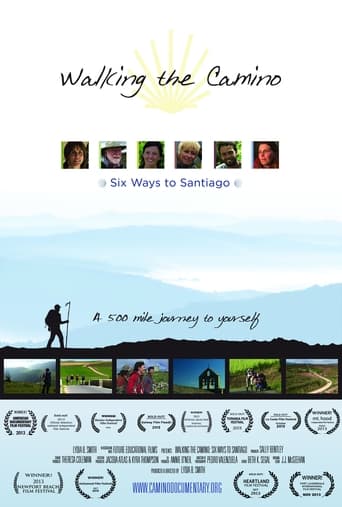manders_steve
This film traces the progress and feelings of a dozen or so people trekking the Camino de Santiago, or Way of St James, to the believed remains of one of Jesus' 12 disciples at the Santiago cathedral. This is an ancient Christian pilgrimage stretching back it seems to at least AD 850. While there are many starting points and routes to Santiago, this film follows people from a range of nationalities, backgrounds, ages and abilities who commence at St Jean Pied de Port in south eastern France, some 800 km from Santiago in north western Spain. We see stunning countryside, intimate moments from those who are suffering, recovering and jubilating from their efforts. The volunteer hostelliers, priests and others they meet along the way enhance the context. The photography makes the film – it is brilliant and without this, the film probably would not have worked. The editing makes the viewer feel the transitions the walkers are experiencing, and must have been a challenge to select the succession of snippets that provide a cohesive narrative. The coda to Finisterre was a masterstroke and ended a well constructed documentary, recommending a high many pilgrims on the route may have overlooked.
David Ferguson
Greetings again from the darkness. There aren't many traditions that span more than 1200 years, and only one of those involves walking 500 miles … the Camino de Santiago. Its origin is as a religious trek to Santiago de Compostela where tradition holds that the magnificent cathedral contains the remains of St. James the Apostle. These days, the Camino is no longer limited to those with Christian beliefs, and in fact many modern day pilgrims take it on as a personal quest rather than a spiritual journey.Director Lydia B Smith and her camera allow us to travel along with a group of (six) pilgrims, each with their own story, background and motivation. The journey involves both physical and emotional challenges, and results in varying degrees of self-awareness. One obvious difference in today's pilgrims versus those of medieval times is the experience is much more communal these days. Not only do the walkers eat and sleep in the same hostels along the route, they also freely share their emotions and thoughts with each other (and the camera). This contrasts greatly with the tradition of solitude and quiet introspection. Call it a lesson in generational differences.The elements rotate between favorable and challenging. The pilgrims must face cold, hot, rain, and wind. These obstacles of nature are magnified with foot blisters, sore knees and other bodily ailments. However, for most of these people, the mental challenge is every bit as steep. For 6 plus hours each day over approximately 35 days, they focus on the incredible scenery as well as their own thoughts. It's impossible to hide from one's self, even though friendship … and even relationships … form along the path.Each of those who complete the journey realizes it's not about the destination, but rather the inspiration and spiritual enlightenment – even if it wasn't their original goal. There is talk about the "internal Camino" and how you walk with your heart. Reflection on this spectacular path leads to harmony with nature and self. A lovely Spanish guitar accompanies our viewing pleasure, and it's impossible not to imagine ourselves on this journey. If inspiration strikes, just be aware that spending that much time with one's self is an activity far removed from our generation's typical day.
clarkj-565-161336
Nowadays we are constantly bombarded by disaster, horror and destruction on a daily basis. When I left the theatre after viewing "Walking the Camino" I was totally relaxed and felt that there was a greater purpose to life. As often happens to me, I had just finished reading a book by Paulo Coelho called "The Pilgrimage" where he describes his experiences on the trek to Santiago de Compostela. He had some pretty momentous stories to tell, so naturally I was extremely interested to find out that others have been doing this walk and also that a movie had been made about it.What makes the movie work for me was that we follow the trek of various couples and individuals from all sorts of different ages, countries of origin and occupations. Without exception, they all seem to experience trans-formative events along their journey and are far more in tune with themselves and the world at the end of the journey. The excessive walking and exercise seems to clean out their system from physical and emotional junk and allows them to appreciate the world that exists right in front of them on a NOW basis. Filming the end of the walk must have been really tough for the film maker, because all the subjects were so emotional about what they had been through and experienced.
Jack Karolewski
This was very well done! The photography, the six main people followed, the music, the mood -- all were well-edited, directed, and produced. It shows the full range of the Camino experience: the internal thoughts, the spiritual insights, the physical strains, the solace of nature, the weather, the new friends made, and the sharing with others of all ages and from all countries. In many aspects, I enjoyed this documentary a little bit more than the commendable Camino film "The Way." (I did the last 200 mile portion to Santiago with my two best friends in 2005, and heartily encourage everyone to give it a try...) This film will truly inspire you. Buen Camino!


